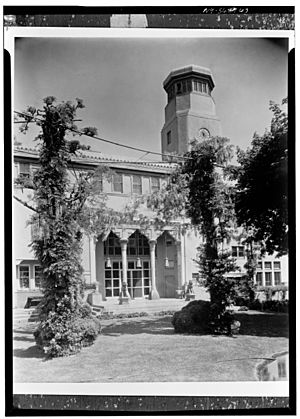Laurelton Hall facts for kids
Laurelton Hall was a huge and beautiful home. It belonged to a famous artist named Louis Comfort Tiffany. This amazing mansion was located in Laurel Hollow, on Long Island, New York.
The house had 84 rooms and sat on 600 acres of land. It was finished in 1905. The design was in a style called Art Nouveau. This style mixed ideas from Islamic art with natural shapes and patterns. Laurelton Hall was not just a home; it was a work of art itself. It also held many of Tiffany's most famous creations.
Contents
What Was Laurelton Hall?
Laurelton Hall was more than just a house. It was a place where art came alive. One visitor, Elizabeth "Bessie" Handforth Kunz, wrote in 1916: "Arabian night’s dreams vanish, at Laurelton a phantom has become reality, eternal." She felt the mansion was like a dream come true.
At that time, the estate had 1,500 acres of forests and waterfront. It was also home to a special school for artists. This school was called the Tiffany Art Foundation. Bessie's father, Dr. George Frederick Kunz, helped run it.
A Home for Art and Artists
Starting in 1918, Laurelton Hall became a school for artists. Louis Comfort Tiffany and his Foundation ran this school. The grounds of Laurelton Hall had other important buildings too.
One building held the famous Tiffany Chapel. This chapel was first shown at the 1893 Columbian Exposition. There were also many beautiful Tiffany windows and a separate art gallery building.
The Sad End and What Was Saved
After Louis Comfort Tiffany passed away, Laurelton Hall started to fall apart. The Foundation sold the estate in 1949 for only $10,000. It had cost about $2,000,000 to build and landscape. Sadly, the mansion burned down in 1957.
Even after the fire, many parts of Laurelton Hall were saved. Hugh McKean and Jeannette Genius McKean rescued most of the windows and other architectural pieces. They shipped these treasures to Winter Park, Florida. Today, you can see them at the Charles Hosmer Morse Museum of American Art.
In November 2006, a big exhibit about Laurelton Hall opened. It was held at the Metropolitan Museum of Art in New York. In 2010, the Morse Museum announced plans for new galleries. These galleries, costing $5 million, would have 6,000 square feet (557 square meters) of space. They would display Tiffany's amazing work from Laurelton Hall.
See also
 In Spanish: Laurelton Hall para niños
In Spanish: Laurelton Hall para niños



